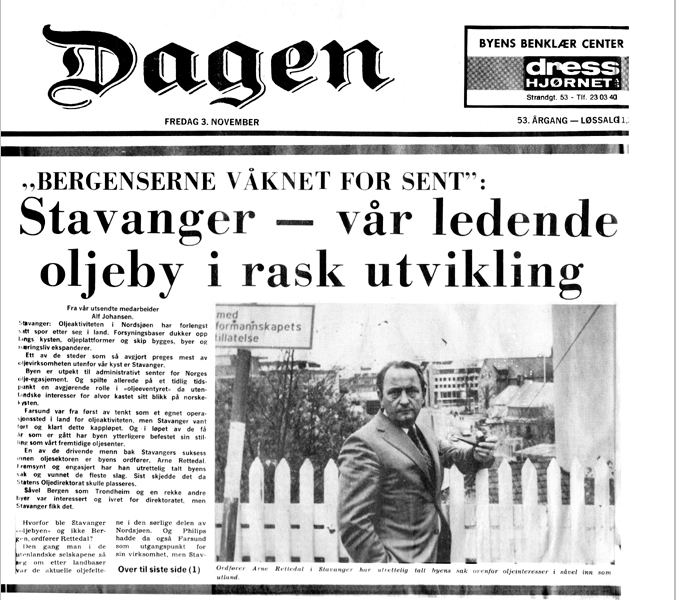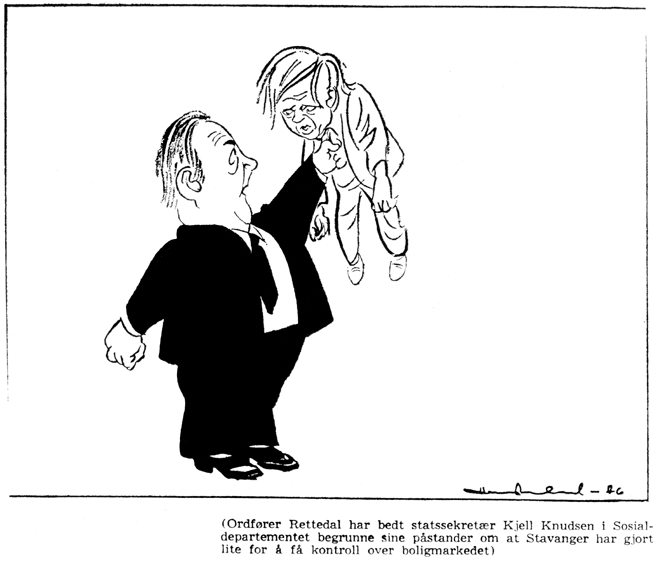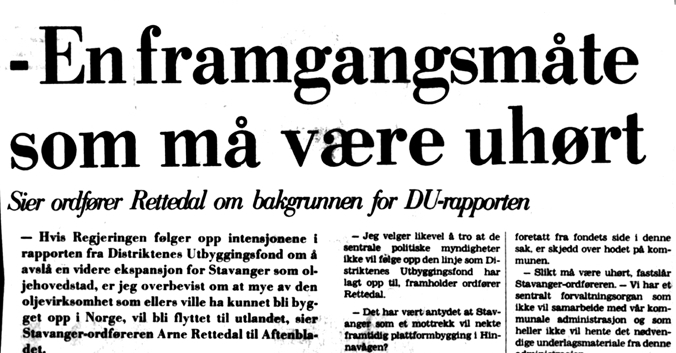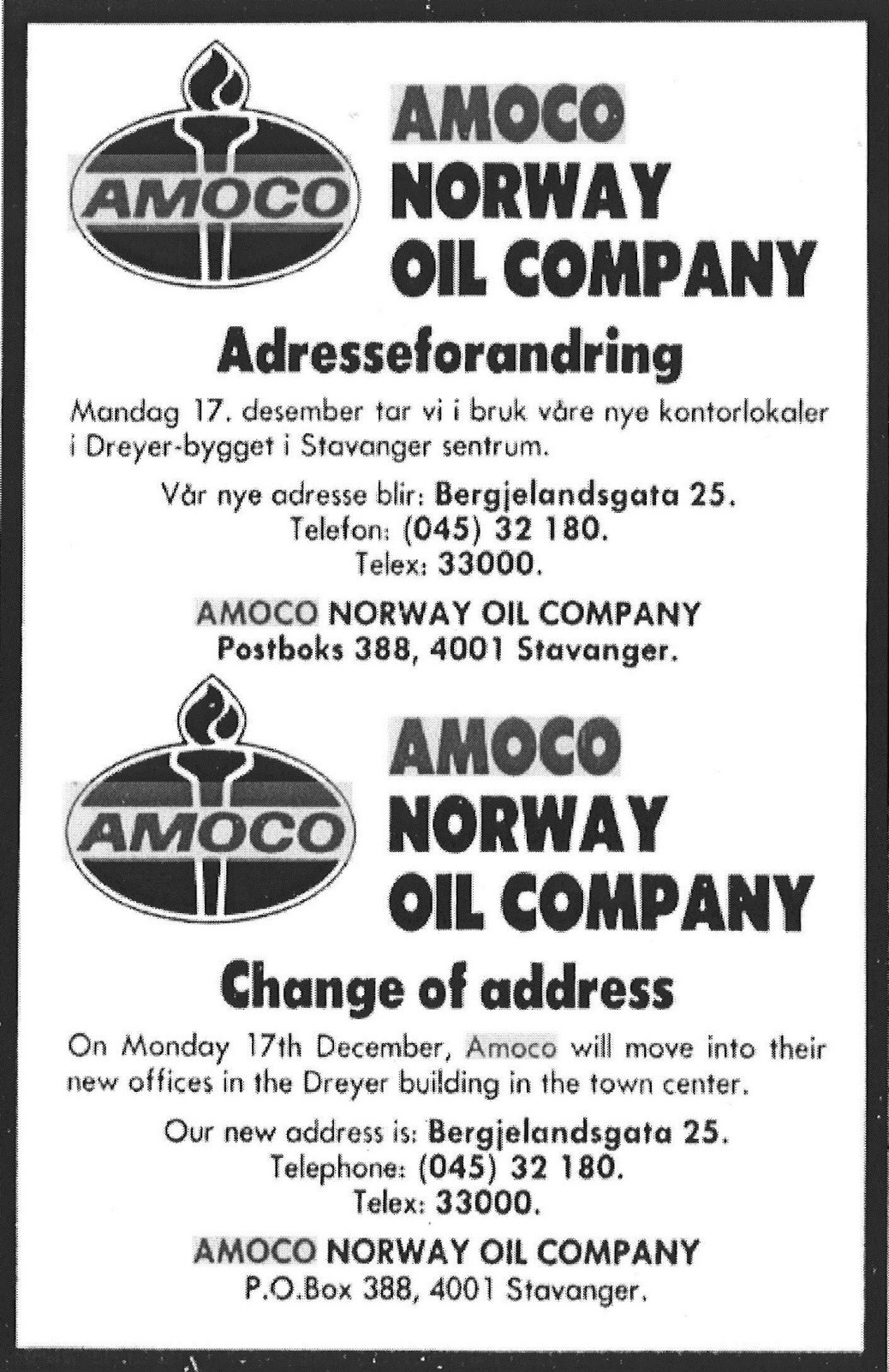Amoco relocates to Stavanger

The discoveries of Hod and Valhall in 1974–75 made it clear that Amoco faced major development assignments at the southern end of the Norwegian continental shelf (NCS).
In those circumstances, the company could expect to expand and to need larger premises for more employees. The 66 staff in 1978 were due to grow to almost 150.
Instead of leasing a planned new building at Aker Norsco, however, Amoco decided to rent 3 500 square metres in the Dreyer building at Bergelandsgata 25 in Stavanger.[REMOVE]Fotnote: Ministry of Labour and Local Government. Archive 700.35. Company establishment cases. Rogaland. RSL/EJ 1.11.1978 A.N. Ref no 84/1978-79.
So why did local daily Stavanger Aftenblad write on 23 June 1978: “Will Stavanger say no to offices? Discussion on principles under way in the executive board”? Was it the case that Stavanger did not want more oil companies to set up shop in the city? What was the background for this discussion?
Overheating problems in Stavanger
The level of economic activity in Stavanger during the first half of the 1970s was unusually high compared with the previous decade. In 1972, for instance, the Storting (parliament) voted to locate Statoil and the NPD in the city because oil operations were already concentrated there.
Development of the Ekofisk and Frigg fields in the North Sea meant that oil company staff expanded. Great activity at the supply bases and construction of the Ekofisk tank and several concrete production platforms employed hundreds of workers.
 Amoco etablerer seg i Stavanger
Amoco etablerer seg i StavangerAll this put pressure on the local labour and housing markets. However, the city council maintained that it was handling the increased demand well. But central government wanted an instrument in case it needed to control such matters as the location of construction sites for concrete platforms. It accordingly introduced a provisional Act in 1973 to regulate the establishment of companies.
This was replaced by a permanent measure on 20 February 1976, which came into force on 1 January 1977. By then, the Statfjord field was in an early development phase with Mobil as operator and Valhall was to be developed.
So Amoco was not the only oil company which increased its workforce and needed bigger premises in this period. That also applied to such players as Norsk Hydro, Elf, Agip and Shell, who all had to apply to the Ministry of Local Government and Labour for permission to establish operations.
During this period, Labour government policy shifted from concentrating petroleum activities in Stavanger – exemplified by locating Statoil and the NPD there – to spreading their growth north along the coast.
Other towns large and small were also to enjoy oil industry spin-offs, so that petroleum benefited the whole nation. The Establishment Act could be used to implement that policy.[REMOVE]Fotnote: Kristin Øye Gjerde, unpublished MSc thesis, Stavanger som oljeby. Stavanger kommunes oljepolitikk 1965–1980 (1993), 110–111.
This was quite clearly expressed by the Ministry of Petroleum and Energy on 8 June 1978: “The number of oil companies in the Stavanger region is now so large as to make any further expansion undesirable”.[REMOVE]Fotnote: Kristin Øye Gjerde, unpublished MSc thesis, Stavanger som oljeby. Stavanger kommunes oljepolitikk 1965–1980 (1993), 115.
Increasingly obvious during 1978, the policy shift aroused concern in Stavanger. The question was how to respond. Loyalty to the government was naturally strongest in the local Labour Party.
Hilmar Egeli, one of its representatives on the council’s executive board, asked in June 1978 whether it was not soon time to reject new company arrivals. He questioned whether Stavanger needed the jobs.
 Amoco etablerer seg i Stavanger
Amoco etablerer seg i StavangerThese views were sharply opposed by Hall Guttelvik, the council’s chief financial officer. He noted that net inward migration to the city in 1977 totalled only 90–100 families, while 1 000 new flats were built in the same year.
Arne Rettedal, the Conservative mayor, maintained that the growth taking place in Stavanger was well within the limits agreed by all the city’s main political parties in its general plan.
Fellow Conservatives Tore Husebø and Lars Vaage highlighted Stavanger’s responsibility as Norway’s “oil capital” to offer homes and office premises.
However, Labour’s Olav T Laake had a proposal: “Stavanger council should ask [neighbouring] Sola local authority whether Norske Shell might not be allowed to establish itself where it was already located?
“Many suspect that Stavanger is grabbing as many jobs as possible. It would create trust among our neighbours if we asked them whether they could contemplate offering expansion opportunities to the oil companies.”[REMOVE]Fotnote: Stavanger Aftenblad , 23 June 1978, “Vil Stavanger si nei til kontorer?”
Laake hoped that Stavanger, by showing a little flexibility, would have something in hand to counter the ministry with. But local government minister Arne Nilsen told the cabinet in July 1978 that “expansion in the Stavanger area remains at an unacceptably high level”.
He took the view that it was important to develop alternative oil centres north of Stavanger as soon as possible with an eye to the development of the northernmost North Sea.[REMOVE]Fotnote: Kristin Øye Gjerde, unpublished MSc thesis, Stavanger som oljeby. Stavanger kommunes oljepolitikk 1965–1980 (1993), 118.
For its part, the petroleum ministry pointed out the desirability of giving companies who had been awarded operator status appropriate conditions for doing their work.[REMOVE]Fotnote: Ministry of Labour and Local Government. Archive 700.35. Company establishment cases. Rogaland. E-sak 153/1978.
For and against in Amoco’s application
The last of these arguments came to carry the heaviest weight for Amoco’s application to acquire larger offices in Stavanger. Emphasis was given to the company’s Valhall development.
Three platforms were to be installed in 1979, with drilling in 1980 and production starting the year after. Several billion kroner was being invested, and the company needed good working conditions.
Amoco was in the process of recruiting more engineers, production personnel and safety specialists. A design department in Oslo was also scheduled to move to Stavanger.
Even with 150 staff, the company would have a relatively small organisation. That made it important for everyone to be in the same place in order to ensure good internal communication.
Amoco maintained that the company needed to be located in Stavanger because it was constantly in touch with the NPD and had close contacts with Statoil.
As a partner in the Ekofisk licence, and because oil and gas from Valhall were to be piped via that field, it was also important for Amoco to be close to operator Phillips Petroleum.
In addition, the company possessed a holding in Statfjord, and Mobil, which was operator for that field, also had offices in Stavanger.
In order to meet the government halfway, Amoco had stated in writing that – should it secure licence interests further north in the fourth or fifth licensing rounds, and should discoveries be made in this acreage – it would be natural to establish branch offices between Bergen and Trondheim in a possible development and production phase.
The establishment case was recommended by the City of Stavanger, the county employment office, the planning and development department of Rogaland county council, the county executive board and the labour and employment board, and also secured an endorsement from the Ministry of Petroleum and Energy.
The Regional Development Fund (DU) concluded that it would be hard for Amoco to expand outside the Stavanger area in relation to the Valhall development.
That the DU found this decision difficult can be seen from the following comment: “Despite its reservations, the secretariat would recommend that Amoco receives consent to use premises at Dreyer A.S with a ceiling of 150 employees. The company has accepted this ceiling in writing.”
The Ministry of Local Government and Labour also had its doubts, but found that it had to give weight to the DU’s recommendation.
Amoco Norway Oil Company accordingly received consent to occupy offices at the Dreyer building in Stavanger. This decision was approved by royal decree on 3 November 1978.[REMOVE]Fotnote: Ministry of Labour and Local Government. Archive 700.35. Company establishment cases. Rogaland. RSL/EJ 1.11.1978 A.N. Ref no 84/1978-79.
An outcome Stavanger could live with
Amoco accordingly got its way in the end. Before the outcome was clear, however, the way this and other company establishment cases in Rogaland had been handled by the local government ministry created great frustration.
On 4 August, Rettedal maintained that the government’s policy was confused in relation to earlier guidelines. Stavanger had undertaken obligations when the Storting voted to locate Statoil and the NPD in the city, he said.[REMOVE]Fotnote: Stavanger Aftenblad, 4 August 1978, “Agip avvises i Rogaland?”
 Amoco etablerer seg i Stavanger
Amoco etablerer seg i StavangerAnd the mayor was furious when the DU secretariat recommended on 24 August 1978 that all oil-related growth in Rogaland must cease.
He told Stavanger Aftenblad that the report was unparalleled in Norwegian public administration. Its conclusions were reached on the basis of inaccurate information about jobs in the region.
Rettedal perceived the recommendation as an accusation that the City of Stavanger had failed to stay on top of developments. He described the failure of its authors to contact the council, either administratively or politically, as shocking.
Were the government to follow up the DU’s proposed rejection of further expansion in Stavanger, he feared that much of the oil activity which might otherwise have been built up in Norway would be moved abroad.[REMOVE]Fotnote: Stavanger Aftenblad , 5 September 1978, “En fremgangsmåte som må være uhørt”.
A clarification meeting between the politicians in Stavanger’s finance committee, local government minister Nilsen and environment minister Gro Harlem Brundtland led to a rather more conciliatory approach.
Petroleum minister Bjartmar Gjerde also expressed limited support for the city: “In my opinion, the oil industry which has been established in Stavanger must be given reasonable working conditions …
“On the other hand, we must relocate oil activities which don’t necessarily need to lie in Stavanger to other places, in line with the regional policy goals drawn up for petroleum operations in Norway.”[REMOVE]Fotnote: Rogalands Avis , 6 September 1978, “Må sikres rimelige vilkår”.
The final decisions on the guidelines which should apply for practising the Establishment Act were taken in a cabinet meeting of 28 September 1978.
Published on 6 October that year, the conclusion was: “New oil companies which are to be established in Norway should be located in their entirety outside the Stavanger area”.[REMOVE]Fotnote: Stavanger Aftenblad , 9 October 1978, “Nye oljeselskaper ikke til Stavanger”.
As noted above, Amoco received a positive response to its application in November 1978 on condition that the workforce was limited to 150 people and that it promised to establish a branch office between Bergen and Trondheim if the company found oil and gas further north.
Similar terms were set for other oil companies who sought permission to establish offices between 1977 and 1980, including Agip, Elf, Hydro, Mobil, BP and Statoil.[REMOVE]Fotnote: Several cases in the Ministry of Labour and Local Government. Archive 700.35. Company establishment cases. Rogaland.
Local politicians in Stavanger were no longer so concerned. If the companies which were already established secured acceptable working conditions, it was not necessary to take an overly pessimistic view.[REMOVE]Fotnote: Stavanger Aftenblad, 9 October 1978, “Vi får nå se på praksis”.
Next to the Light of the World
 Amoco etablerer seg i Stavanger
Amoco etablerer seg i StavangerAmoco secured a 15-year lease at the Dreyer building in Bergelandsgata and moved in during 1981. The company stayed there until 1995, when it moved to new premises at Verven 4.
Bergelandsgata was renowned from before for its chapels – there were about 20 of them. Amoco was next door to the building where the illuminated sign Jesus – Verdens Lys (Jesus – Light of the World) shone across Stavanger’s central Breiavatnet lake towards the Hotel Atlantic.
A guest of Amoco who was staying at the hotel asked what the sign meant. When its message was explained to him, the American thought for a moment before commenting: “Amoco should apply to get a sign which reads ‘and Amoco provides the fuel …’.”[REMOVE]Fotnote: Stavanger Aftenblad , 11 April 1981, “Mange etableringer i Stavanger-området”. The county council’s executive board gave consent for the creation of an oil base at Torvastad in Karmøy local authority north of Stavanger for contractor McDermott’s lease of the former Storesund Salteri og Kraftforfabrikk factory in connection with its assignment on Valhall. McDermott hired 3 800 square metres of outside storage space.
The creation of Saga PetroleumAmoco etablerer seg i Stavanger